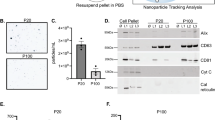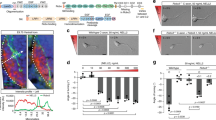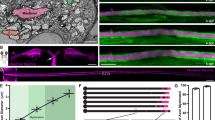Abstract
Growth cones at the tips of nascent and regenerating axons direct axon elongation. Netrin-1, a secreted molecule that promotes axon outgrowth and regulates axon pathfinding, elevates cyclic AMP (cAMP) levels in growth cones and regulates growth cone morphology and axonal outgrowth. These morphological effects depend on the intracellular levels of cAMP. However, the specific pathways that regulate cAMP levels in response to netrin-1 signaling are unclear. Here we show that 'soluble' adenylyl cyclase (sAC), an atypical calcium-regulated cAMP-generating enzyme previously implicated in sperm maturation, is expressed in developing rat axons and generates cAMP in response to netrin-1. Overexpression of sAC results in axonal outgrowth and growth cone elaboration, whereas inhibition of sAC blocks netrin-1–induced axon outgrowth and growth cone elaboration. Taken together, these results indicate that netrin-1 signals through sAC-generated cAMP, and identify a fundamental role for sAC in axonal development.
This is a preview of subscription content, access via your institution
Access options
Subscribe to this journal
Receive 12 print issues and online access
$209.00 per year
only $17.42 per issue
Buy this article
- Purchase on Springer Link
- Instant access to full article PDF
Prices may be subject to local taxes which are calculated during checkout








Similar content being viewed by others
References
Song, H. & Poo, M. The cell biology of neuronal navigation. Nat. Cell Biol. 3, E81–E88 (2001).
Serafini, T. et al. The netrins define a family of axon outgrowth-promoting proteins homologous to C. elegans UNC-6. Cell 78, 409–424 (1994).
Kennedy, T.E., Serafini, T., de la Torre, J.R. & Tessier-Lavigne, M. Netrins are diffusible chemotropic factors for commissural axons in the embryonic spinal cord. Cell 78, 425–435 (1994).
Tucker, K.L., Meyer, M. & Barde, Y.A. Neurotrophins are required for nerve growth during development. Nat. Neurosci. 4, 29–37 (2001).
Nishiyama, M. et al. Cyclic AMP/GMP-dependent modulation of Ca2+ channels sets the polarity of nerve growth-cone turning. Nature 423, 990–995 (2003).
Hopker, V.H., Shewan, D., Tessier-Lavigne, M., Poo, M. & Holt, C. Growth-cone attraction to netrin-1 is converted to repulsion by laminin-1. Nature 401, 69–73 (1999).
Hong, K. et al. A ligand-gated association between cytoplasmic domains of UNC5 and DCC family receptors converts netrin-induced growth cone attraction to repulsion. Cell 97, 927–941 (1999).
Metin, C., Deleglise, D., Serafini, T., Kennedy, T.E. & Tessier-Lavigne, M. A role for netrin-1 in the guidance of cortical efferents. Development 124, 5063–5074 (1997).
Serafini, T. et al. Netrin-1 is required for commissural axon guidance in the developing vertebrate nervous system. Cell 87, 1001–1014 (1996).
Seaman, C., Anderson, R., Emery, B. & Cooper, H.M. Localization of the netrin guidance receptor, DCC, in the developing peripheral and enteric nervous systems. Mech. Dev. 103, 173–175 (2001).
Keino-Masu, K. et al. Deleted in colorectal cancer (DCC) encodes a netrin receptor. Cell 87, 175–185 (1996).
Shekarabi, M. & Kennedy, T.E. The netrin-1 receptor DCC promotes filopodia formation and cell spreading by activating Cdc42 and Rac1. Mol. Cell. Neurosci. 19, 1–17 (2002).
Shekarabi, M. et al. Deleted in colorectal cancer binding netrin-1 mediates cell substrate adhesion and recruits Cdc42, Rac1, Pak1, and N-WASP into an intracellular signaling complex that promotes growth cone expansion. J. Neurosci. 25, 3132–3141 (2005).
Ming, G.L. et al. cAMP-dependent growth cone guidance by netrin-1. Neuron 19, 1225–1235 (1997).
Lohof, A.M., Quillan, M., Dan, Y. & Poo, M.M. Asymmetric modulation of cytosolic cAMP activity induces growth cone turning. J. Neurosci. 12, 1253–1261 (1992).
Spencer, T. & Filbin, M.T. A role for cAMP in regeneration of the adult mammalian CNS. J. Anat. 204, 49–55 (2004).
Forte, L.R., Bylund, D.B. & Zahler, W.L. Forskolin does not activate sperm adenylate cyclase. Mol. Pharmacol. 24, 42–47 (1983).
Buck, J., Sinclair, M.L., Schapal, L., Cann, M.J. & Levin, L.R. Cytosolic adenylyl cyclase defines a unique signaling molecule in mammals. Proc. Natl. Acad. Sci. USA 96, 79–84 (1999).
Sinclair, M.L. et al. Specific expression of soluble adenylyl cyclase in male germ cells. Mol. Reprod. Dev. 56, 6–11 (2000).
Jaiswal, B.S. & Conti, M. Identification and functional analysis of splice variants of the germ cell soluble adenylyl cyclase. J. Biol. Chem. 276, 31698–31708 (2001).
Esposito, G. et al. Mice deficient for soluble adenylyl cyclase are infertile because of a severe sperm-motility defect. Proc. Natl. Acad. Sci. USA 101, 2993–2998 (2004).
Hess, K.C. et al. The “soluble” adenylyl cyclase in sperm mediates multiple signaling events required for fertilization. Dev. Cell 9, 249–259 (2005).
Zippin, J.H. et al. Compartmentalization of bicarbonate-sensitive adenylyl cyclase in distinct signaling microdomains. FASEB J. 17, 82–84 (2003).
Braun, T. & Dods, R.F. Development of a Mn2+-sensitive, “soluble” adenylate cyclase in rat testis. Proc. Natl. Acad. Sci. USA 72, 1097–1101 (1975).
Jaiswal, B.S. & Conti, M. Calcium regulation of the soluble adenylyl cyclase expressed in mammalian spermatozoa. Proc. Natl. Acad. Sci. USA 100, 10676–10681 (2003).
Litvin, T.N., Kamenetsky, M., Zarifyan, A., Buck, J. & Levin, L.R. Kinetic properties of “soluble” adenylyl cyclase. Synergism between calcium and bicarbonate. J. Biol. Chem. 278, 15922–15926 (2003).
Jackman, A. & Fitzgerald, M. Development of peripheral hindlimb and central spinal cord innervation by subpopulations of dorsal root ganglion cells in the embryonic rat. J. Comp. Neurol. 418, 281–298 (2000).
Tessier-Lavigne, M., Placzek, M., Lumsden, A.G., Dodd, J. & Jessell, T.M. Chemotropic guidance of developing axons in the mammalian central nervous system. Nature 336, 775–778 (1988).
Stessin, A.M. et al. Soluble adenylyl cyclase mediates nerve growth factor-induced activation of Rap1. J. Biol. Chem. 281, 17253–17258 (2006).
Su, A.I. et al. A gene atlas of the mouse and human protein-encoding transcriptomes. Proc. Natl. Acad. Sci. USA 101, 6062–6067 (2004).
Pastor-Soler, N. et al. Bicarbonate-regulated adenylyl cyclase (sAC) is a sensor that regulates pH-dependent V-ATPase recycling. J. Biol. Chem. 278, 49523–49529 (2003).
Corset, V. et al. Netrin-1-mediated axon outgrowth and cAMP production requires interaction with adenosine A2b receptor. Nature 407, 747–750 (2000).
Higuchi, H., Yamashita, T., Yoshikawa, H. & Tohyama, M. Functional inhibition of the p75 receptor using a small interfering RNA. Biochem. Biophys. Res. Commun. 301, 804–809 (2003).
Wu, K.Y. et al. Local translation of RhoA regulates growth cone collapse. Nature 436, 1020–1024 (2005).
Waschek, J.A. Multiple actions of pituitary adenylyl cyclase activating peptide in nervous system development and regeneration. Dev. Neurosci. 24, 14–23 (2002).
Guirland, C., Buck, K.B., Gibney, J.A., DiCicco-Bloom, E. & Zheng, J.Q. Direct cAMP signaling through G-protein-coupled receptors mediates growth cone attraction induced by pituitary adenylate cyclase-activating polypeptide. J. Neurosci. 23, 2274–2283 (2003).
Johnson, R.A. et al. Isozyme-dependent sensitivity of adenylyl cyclases to P-site-mediated inhibition by adenine nucleosides and nucleoside 3′-polyphosphates. J. Biol. Chem. 272, 8962–8966 (1997).
Gille, A. et al. Differential inhibition of adenylyl cyclase isoforms and soluble guanylyl cyclase by purine and pyrimidine nucleotides. J. Biol. Chem. 279, 19955–19969 (2004).
Chen, Y. et al. Soluble adenylyl cyclase as an evolutionarily conserved bicarbonate sensor. Science 289, 625–628 (2000).
Nobes, C.D. & Hall, A. Rho, rac, and cdc42 GTPases regulate the assembly of multimolecular focal complexes associated with actin stress fibers, lamellipodia, and filopodia. Cell 81, 53–62 (1995).
Stein, E., Zou, Y., Poo, M. & Tessier-Lavigne, M. Binding of DCC by netrin-1 to mediate axon guidance independent of adenosine A2B receptor activation. Science 291, 1976–1982 (2001).
Moore, S.W. & Kennedy, T.E. Protein kinase A regulates the sensitivity of spinal commissural axon turning to netrin-1 but does not switch between chemoattraction and chemorepulsion. J. Neurosci. 26, 2419–2423 (2006).
Roelofs, J. & Van Haastert, P.J. Deducing the origin of soluble adenylyl cyclase, a gene lost in multiple lineages. Mol. Biol. Evol. 19, 2239–2246 (2002).
Geng, W. et al. Cloning and characterization of the human soluble adenylyl cyclase. Am. J. Physiol. Cell Physiol. 288, C1305–C1316 (2005).
Wang, G.X. & Poo, M.M. Requirement of TRPC channels in netrin-1-induced chemotropic turning of nerve growth cones. Nature 434, 898–904 (2005).
Banker, G. & Goslin, K. Culturing Nerve Cells 2nd edn. (MIT Press, Cambridge, MA, 1998).
de la Torre, J.R. et al. Turning of retinal growth cones in a netrin-1 gradient mediated by the netrin receptor DCC. Neuron 19, 1211–1224 (1997).
Acknowledgements
We thank L.J. Cox for his comments and suggestions. Supported by the US National Institutes of Health (NIH) MH066204 and the Christopher Reeve Paralysis Foundation (S.R.J.); NIH GM07739 and the Barbara and Stephen Friedman Fellowship Endowment (J.H.Z.); NIH 5T32 CA062948 (D.R.H.); NIH 2T32 DA07274 (M.K.); NIH HD38722, the American Diabetes Association and the Hirschl Weill-Caulier Trust (L.R.L.); and NIH HD42060, GM62328 and the Ellison Medical Foundation (J.B.).
Author information
Authors and Affiliations
Corresponding author
Ethics declarations
Competing interests
The authors declare no competing financial interests.
Supplementary information
Supplementary Fig. 1
Expression of sAC in rat neurons. (PDF 144 kb)
Supplementary Fig. 2
Netrin-1 mediates growth cone elaboration through sAC. (PDF 60 kb)
Supplementary Fig. 3
DRG neurons are susceptible to highly efficient siRNA-mediated mRNA knockdown. (PDF 67 kb)
Supplementary Fig. 4
Netrin-1-mediated growth cone elaboration requires cAMP and PKA. (PDF 48 kb)
Supplementary Fig. 5
Differentiation of the roles of tmAC and sAC in growth cone signaling. (PDF 52 kb)
Supplementary Fig. 6
Netrin-1 mediates axon outgrowth through DCC. (PDF 34 kb)
Supplementary Fig. 7
Netrin-1 mediates growth cone elaboration in a dose-dependent manner. (PDF 31 kb)
Rights and permissions
About this article
Cite this article
Wu, K., Zippin, J., Huron, D. et al. Soluble adenylyl cyclase is required for netrin-1 signaling in nerve growth cones. Nat Neurosci 9, 1257–1264 (2006). https://doi.org/10.1038/nn1767
Received:
Accepted:
Published:
Issue Date:
DOI: https://doi.org/10.1038/nn1767
This article is cited by
-
Expression and functions of adenylyl cyclases in the CNS
Fluids and Barriers of the CNS (2022)
-
Context-specific regulation and function of mRNA alternative polyadenylation
Nature Reviews Molecular Cell Biology (2022)
-
Acetate attenuates inflammasome activation through GPR43-mediated Ca2+-dependent NLRP3 ubiquitination
Experimental & Molecular Medicine (2019)
-
Inhibition of Intracellular Type 10 Adenylyl Cyclase Protects Cortical Neurons Against Reperfusion-Induced Mitochondrial Injury and Apoptosis
Molecular Neurobiology (2018)
-
cAMP-dependent cell differentiation triggered by activated CRHR1 in hippocampal neuronal cells
Scientific Reports (2017)



